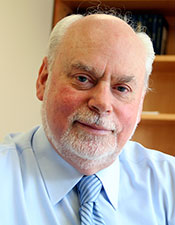Apr 30 2014
Northwestern University professor Sir Fraser Stoddart, a pioneer in the fields of chemistry and nanoscience, has been elected a member of the prestigious U.S. National Academy of Sciences (NAS).
 Sir Fraser Stoddart
Sir Fraser Stoddart
Membership in the NAS is one of the highest honors given to a scientist in the United States. Stoddart is among 84 new members and 21 foreign associates from 15 countries recognized for their distinguished and continuing achievements in original scientific research.
Stoddart, the Board of Trustees Professor of Chemistry in the Weinberg College of Arts and Sciences, will be inducted into the academy next April during its 152nd annual meeting in Washington, D.C.
By introducing an additional type of bond (the mechanical bond) into chemical compounds, Stoddart became one of the few chemists to have opened up a new field of chemistry during the past 25 years. His work in molecular recognition and self-assembly and his subsequent introduction of template-directed routes to mechanically interlocked molecules has changed dramatically the way chemists think about chemical compounds.
Stoddart’s introduction of the mechanical bond, which has led to the fabrication of artificial molecular switches and machines, has been responsible for putting chemists at the forefront of the burgeoning field of nanotechnology, with implications ranging all the way from information technology to health care.
“My research is an opportunity to take a unique class of functioning molecular nanosystems and put them through their paces in different environments and note how their performance changes on going from one setting to another,” Stoddart said. “For there to be any genuinely new nanotechnology, there must first be good, sound nanoscience, based on a fundamental understanding of the principles that emerge from enlightening and penetrating experimentation, carried out in an incremental way in a chemical laboratory.”
Stoddart’s areas of expertise include molecular electronics (using molecules on the nanoscale as the tiniest of switches, which have been incorporated into the densest of memory chips in a device that can hold the Declaration of Independence but is only the size of a white blood cell) and artificial molecular machines (using linear motor-molecules on the surfaces of mesoporous glass nanoparticles to create controllable and targeted drug delivery systems for the treatment of cancer and other degenerative diseases).
There now are 2,214 active National Academy of Sciences members and 444 foreign associates. Approximately 200 living academy members have won Nobel prizes. Among the renowned NAS members are Albert Einstein, Robert Oppenheimer, Thomas Edison, Orville Wright and Alexander Graham Bell.
The academy was established in 1863 by a congressional act of incorporation signed by Abraham Lincoln that calls on the academy to act as an official adviser to the federal government, upon request, in any matter of science or technology.